Labour Force
- Home
- Statistics
- Labour Market
- Labour Market Information
- Labour Force
Key Statistics of Labour Force in Malaysia, July 2021
Principal Statistics of Labour Force, Malaysia, Second Quarter (Q2) 2021 9 August 2021
Key Statistics of Labour Force in Malaysia, June 2021 8 July 2021
Key Statistics of Labour Force in Malaysia, May 2021 9 June 2021
Key Statistics of Labour Force in Malaysia, April 2021 7 May 2021
Key Statistics of Labour Force in Malaysia, March 2021 7 May 2021
Principal Statistics of Labour Force, Malaysia, First Quarter (Q1) 2021 Show all release archives
Overview
_v8-01-01.png)
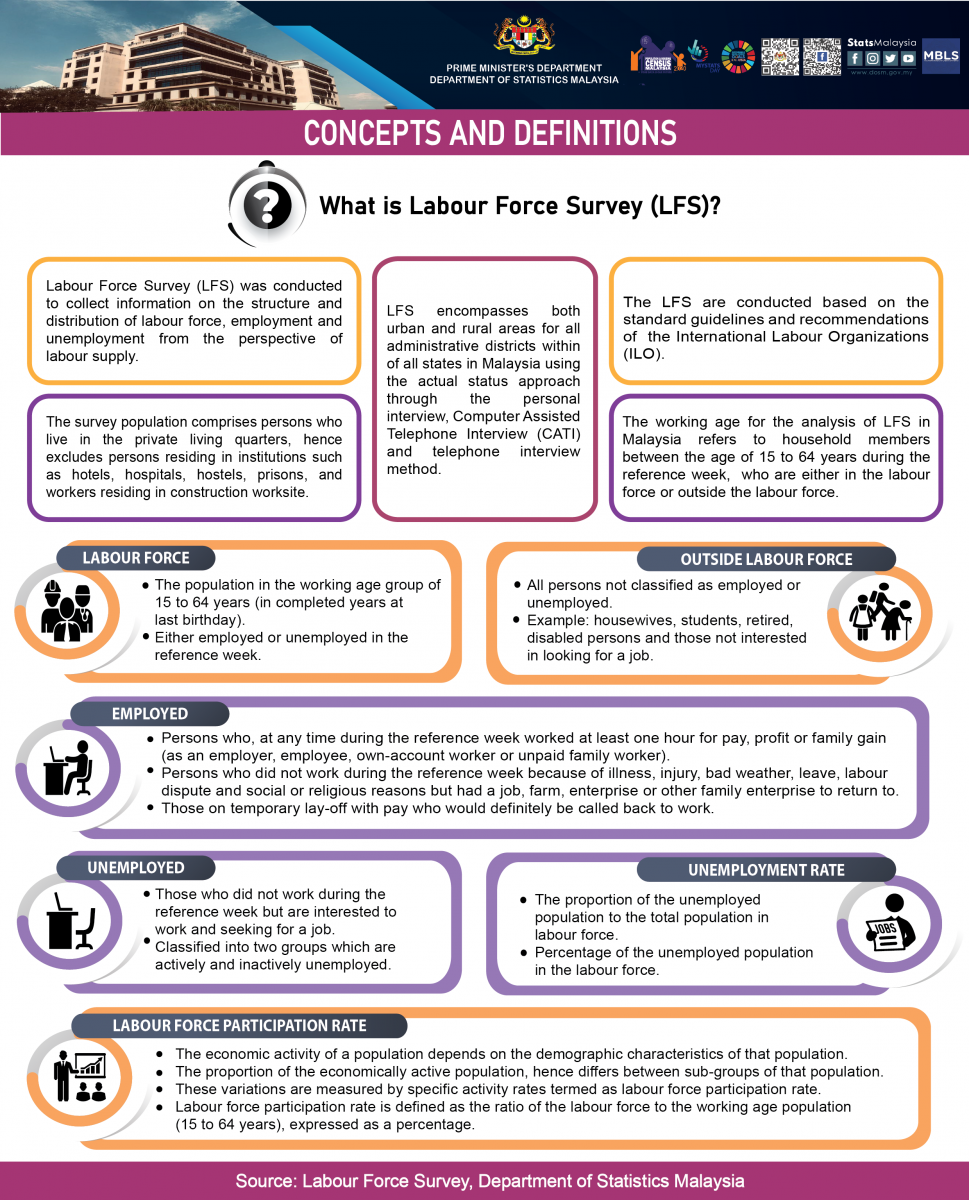
KEY REVIEWS
- Employed persons declined with a slight decrease of 2.7 thousand persons to 15.29 million persons in July 2021 (June 2021: 15.30 million persons). This was the second month of the reduction after recording a positive trend for six months. The employment-to-population ratio which indicates the ability of an economy to create employment stagnated at 65.0 per cent in July 2021.
- By economic sector, all sectors posted month-on-month decreases in July 2021 except for Services sector with little positive change after registering a decline in the previous month. Food & beverages services, Transport & storage and Information & communication were among the main contributors to the positive growth in Services sectors.
- The employee’s category which accounted for 77.6 per cent of total employed persons, reduced by 4.4 thousand persons to record 11.87 million persons in July 2021. Nevertheless, own-account workers continued to post a positive change for six consecutive months with an addition of 6.8 thousand persons (0.3%) to 2.50 million persons in July 2021.
- In July 2021, the unemployment rate remained unchanged at 4.8 per cent after registering a positive month-on-month change in the previous month. The number of unemployed persons increased further albeit at a slower rate by 1.2 per cent (9.5 thousand persons) to record 778.2 thousand persons (June 2021: 5.6%; 768.7 thousand persons).
- The number of labour force in July 2021 was sligtly higher by 6.7 thousand persons to post 16.07 million persons after registering decreases in the preceding months. The labour force participation rate (LFPR) during the month stood at 68.3 per cent.
- In July 2021, the number of outside labour force continued to increase for the fourth month by 0.3 per cent or 18.7 thousand persons to register 7.48 million persons (June 2021: 7.46 million persons). Housework/ family responsibilities was the major composition of outside labour force with a contribution of 46.4 per cent and followed by schooling/ training category (39.2%).
- Generally, the labour market is positively associated with the economic performance. Hence, the implementation of NRP has allowed some flexibility for economic and services activities to resume in line with the NRP’s phases. This targeted strategy has brought some light for the labour market to recover progressively. With the permission for more business activities to reopen under Phase 1 along with transitions of some states into Phase 3 and Phase 4, more labour market activities are foreseen in the upcoming months. Nonetheless, due to uncertain public health situation, the challenges to the labour market may persist. On this note, collaboration and awareness of the whole nation comprising of individuals, community as well as businesses are crucial to ensure herd immunity can be achieved, thus will be able to revive the country's economy and labour market.
EMPLOYMENT CONTINUED TO DECLINE IN JULY 2021 AMIDST THE PROLONGED HEALTH CRISIS CAUSED THE RISING NUMBER OF UNEMPLOYED PERSONS
At the beginning of July 2021, the whole nation was shifted to Phase 1 of National Recovery Plan (NRP) considering the high number of COVID-19 new cases continued amid the ascending vaccination rate. Later, eight states namely Perlis, Kelantan, Terengganu, Pahang, Perak, Pulau Pinang, Sabah and Sarawak had moved into Phase 2 of NRP in stages with the eased of restriction that allowed more economic activities to operate with adherence to standard operating procedures (SOPs). This signalled some positive effects to the economy and subsequently to the labour force situation in these states. Nevertheless, eight states remained in Phase 1 of NRP namely Johor, Kedah, Melaka, Negeri Sembilan, Selangor, Wilayah Persekutuan Kuala Lumpur, Wilayah Persekutuan Labuan and Wilayah Persekutuan Putrajaya. The number of labour force in these states encompassed approximately 52 per cent of the total Malaysia’s labour force. As for Selangor and Wilayah Persekutuan Kuala Lumpur, most districts and localities in both states were in Restricted Movement Control Order (RMCO) starting from 3 to 16 July 2021 which had caused non-essential economic and services activities to be halted. Phase 2 of NRP witnessed permission for operations of more economic activities with compliance to SOPs. As for the Civil service, attendances at the office are allowed to maximum of 40 per cent on rotation basis excluded the front liners, security, defence and enforcement services. Meanwhile for the private sectors, employee’s attendance capacity for the essential services including operations and management is limited to 80 per cent.
Within Phase 2, longer business hours are allowed for restaurants, eateries, dining outlets, food trucks, hawkers, food courts, roadside stalls or kiosks with operations between 6:00am to 10:00pm. Nevertheless, dine-in and park & dine services remained prohibited. In the meantime, grocery and convenience stores, daily necessity stores such as hardware stores; vehicle workshops; baby goods and religious goods stores; supermarkets; hypermarkets & departmental stores; pharmacies; personal care stores; book and stationery stores; computer and telecommunications and electrical goods stores; hairdresser and beauty salons (basic haircut services only); veterinarians & pet food stores; laundry services; self-service laundromats; car wash operators; and optical stores are allowed to operate from 8:00am to 8:00pm. Whereas, healthcare services such as hospitals, clinics, and medical laboratories were permitted to operate for 24 hours. Petrol stations are allowed to operate from 6:00am to 8:00pm except those in highways. Meanwhile, day markets & public markets, control fresh markets, Permanent Farmers’ Markets and others are allowed to operate for certain period between 6:00am to 4:00pm while night markets and weekly markets are not allowed to operate. During this period, inter-state and inter-district travelling activities are still banned.
Thus, employment continued to decline in July amidst the prolonged health crisis which had caused the rising number of unemployed persons resulting to a slight increase in the labour force. In addition, Malaysia’s Leading Index (LI) which anticipates the economic direction in the near future declined further month-on-month with 2.8 per cent (May 2021: -2.9%) mirrored by the reduction in all LI components. This indicates that a slower economic outlook is predicted for Malaysia in the forthcoming months. Year-on-year, LI continued to record an increase albeit at smaller rate of 0.5 per cent as against the previous month (April 2021: 6.9%). Meanwhile, the monthly indicators for exports declined by 18.6 per cent month-on-month while imports continued to post a positive growth of 0.5 per cent.
The Labour Force Report for July 2021 describes the labour supply situation as the country entered the various phases of MCO and NRP. The report will elaborate on the month-on-month changes to examine the immediate effects of the MCO to contain the spread of COVID-19. Users are advised to interpret the monthly statistics with caution since they are non-seasonally adjusted. In addition, annual changes from the same month of the previous year are also reported.
Employed persons declined further with a slight decrease of 2.7 thousand persons
Employed persons declined further with a slight decrease of 2.7 thousand persons to 15.29 million persons in July 2021 (June 2021: 15.30 million persons). This was the second month of the reduction after recording a positive trend for six months. However, in comparison to the same month of the previous year, the number of employed persons remained elevated for the fifth month by 1.5 per cent or 221.4 thousand persons (July 2020: 15.07 million persons).
By economic sector, all sectors posted month-on-month decreases except for Services sector with little positive change after registering a decline in the previous month. Food & beverages services; Transport & storage; and Information & communication were among the main contributors to the positive growth in Services sector.
The employment-to-population ratio which indicates the ability of an economy to create employment stagnated at 65.0 per cent in July 2021. However, the ratio increased by 0.1 percentage points as against the same month of the preceding year (July 2020: 64.9%). [Chart 1]
Chart 1: Employed persons and employment-to-population ratio, January 2018 - July 2021
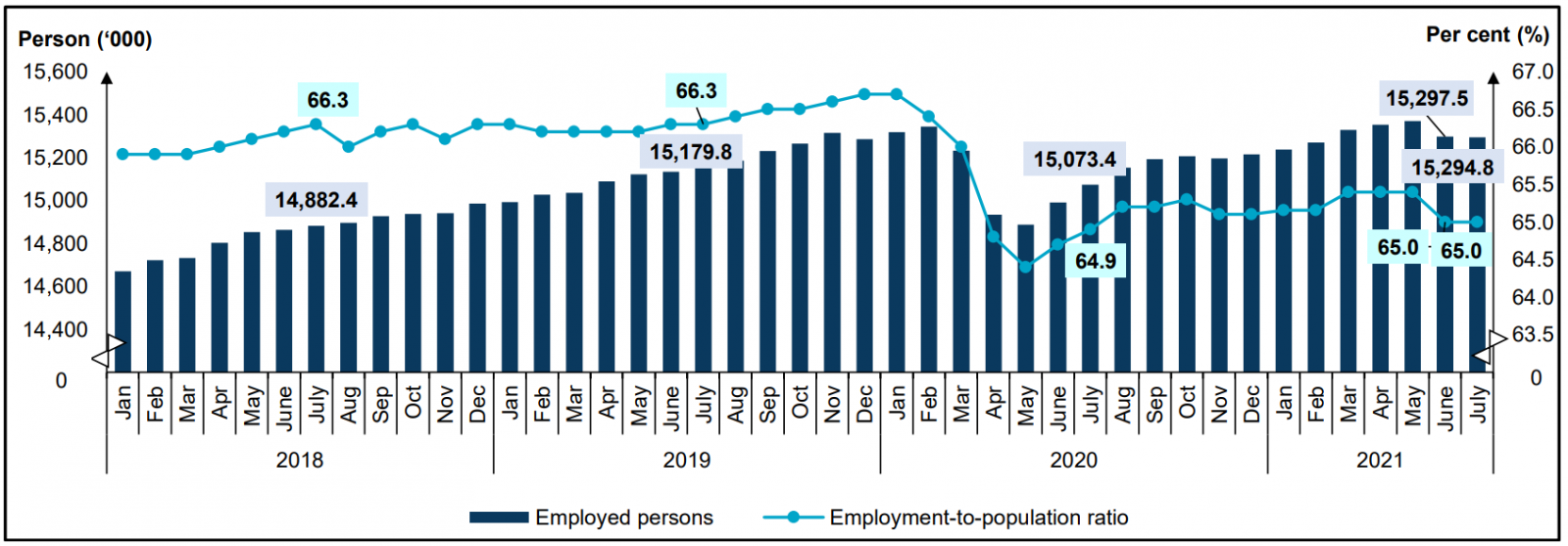
The employee’s category which accounted for 77.6 per cent of total employed persons, reduced by 4.4 thousand persons to record 11.87 million persons in July 2021. Nevertheless, own-account workers continued to post a positive change for six consecutive months with an addition of 6.8 thousand persons (0.3%) to record 2.50 million persons in July 2021. The continuous improvement in this group was partly due to the permission of small businesses such as food or beverage stalls or hawkers to remain operating during the NRP period. This group comprised mostly of daily income earners working as small business operators such as small retailers; hawkers; sellers in markets and stalls as well as smallholders. [Chart2]
Chart 2: Employed person by status of employment, June and July 2021
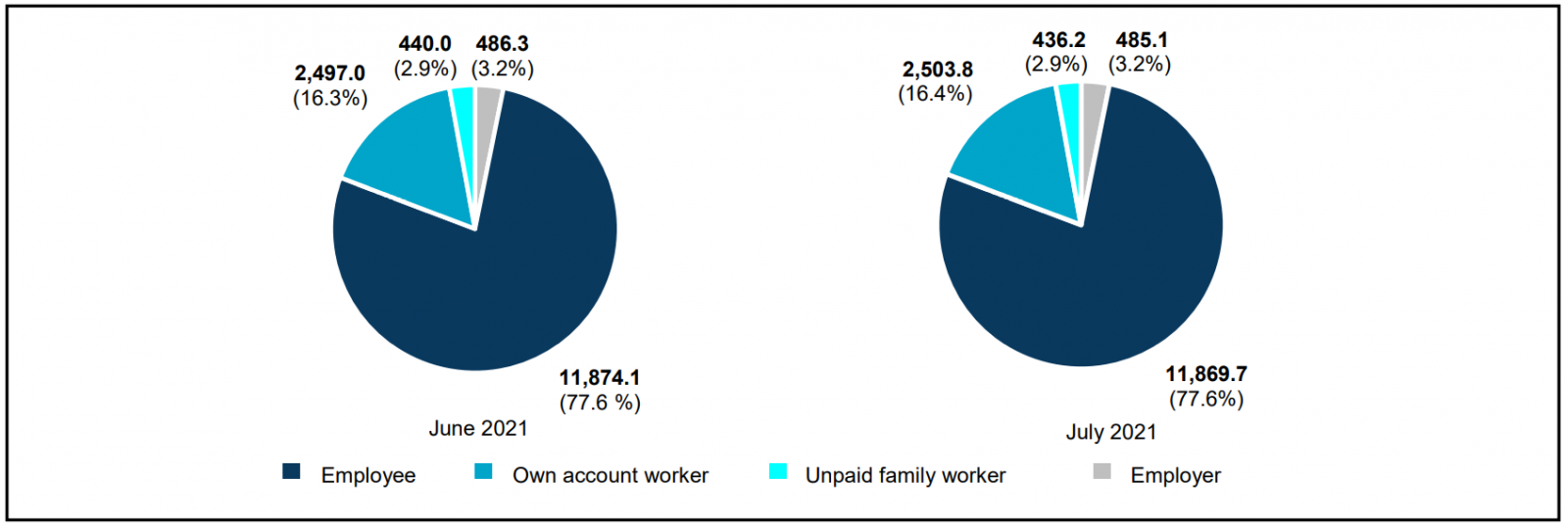
As more economic and services sectors were permitted to operate with compliance to SOPs during Phase 1 and Phase 2 of NRP, the number of employed persons who were temporarily not working declined by 24.8 thousand persons to record 776.3 thousand persons (June 2021: 801.1 thousand persons) after registering an increase for two consecutive months. However, year-on-year, the number of employed persons in this category increased by 671.9 thousand persons (July 2020: 104.3 thousand persons) whereby the country was in the Recovery MCO phase during that period. This group of persons, who were most likely not able to work was not categorised as unemployed as they had work to return to.
The unemployment rate in July 2021 remained unchanged at 4.8 per cent
In July 2021, the unemployment rate remained unchanged at 4.8 per cent after registering a positive month-on-month change in the previous month. The number of unemployed persons increased further albeit at a slower rate by 1.2 per cent (9.5 thousand persons) to record 778.2 thousand persons (June 2021: 5.6%; 768.7 thousand persons).
The unemployment rate increased slightly by 0.1 percentage point (July 2020: 4.7%) year-on-year whereby the number of unemployed persons rose by 4.4 per cent or an addition of 33.1 thousand persons to record 745.1 thousand persons in July 2020. [Chart 3]
Chart 3: Unemployed persons and unemployment rate, 1982 - 2020 and January 2020 - July 2021
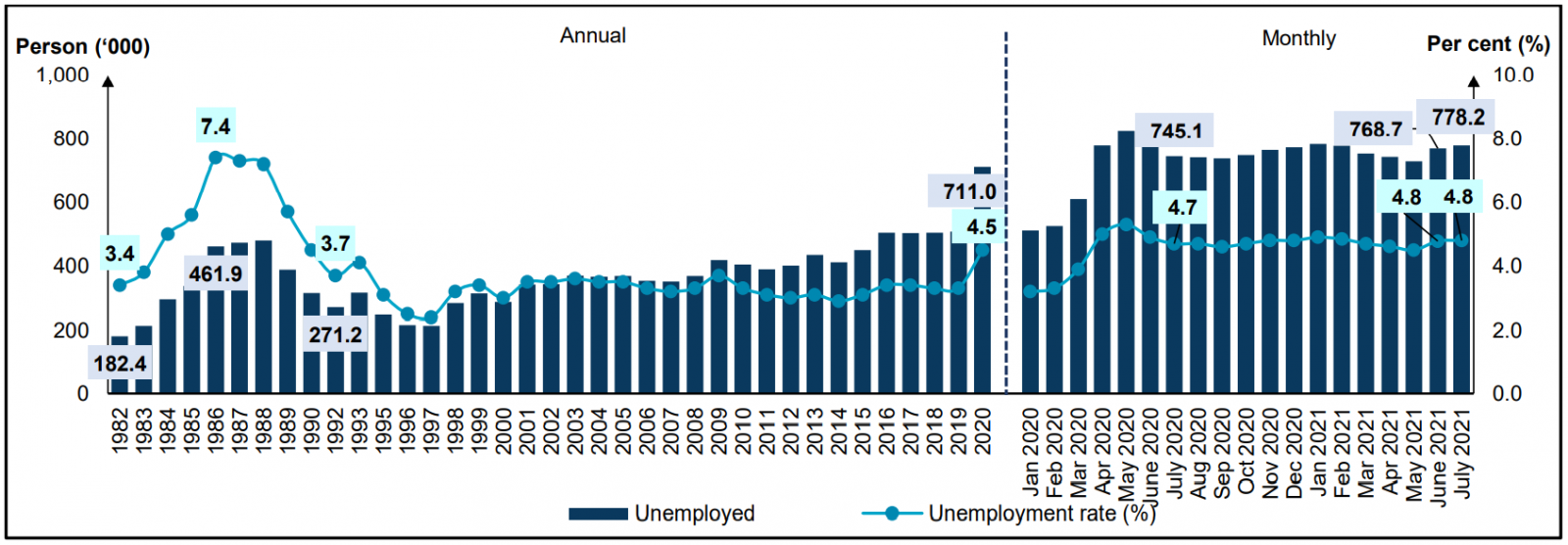
By unemployment category, the actively unemployed or those who were available for work and were actively seeking job surged by 8.4 thousand persons to 651.3 thousand persons (June 2021: 642.9 thousand persons). This group comprised of 83.7 per cent of total unemployed persons. The group of unemployed for less than three months accounted for 53.9 per cent of the actively unemployed, whereas the remaining of 8.8 per cent encompassing those who were in long-term unemployment of more than a year1 . As for the inactively unemployed who believed that there were no jobs available, the number increased slightly by 1.1 thousand persons (+0.8%) to 126.9 thousand persons (June 2021: 6.4%; 125.8 thousand persons). [Chart 4]
Chart 4: Unemployed category and duration of unemployment, June and July 2021

During the month, the youth unemployment rate for aged 15 to 24 years posted an increase of 1.0 percentage point to 13.7 per cent after recording a decline for two consecutive months (June 2021: 12.7%). Accordingly, the number of unemployed youths climbed by 3.1 thousand persons to 344.1 thousand persons (June 2021: 340.9 thousand persons). On the contrary, the unemployment rate for youth aged 15 to 30 years dropped 0.9 percentage points to record a rate of 8.5 per cent (June 2021: 9.4%). [Chart 5]
Chart 5: Unemployment rate by selected age groups, 1982 - 2020 and January 2020 - July 2021
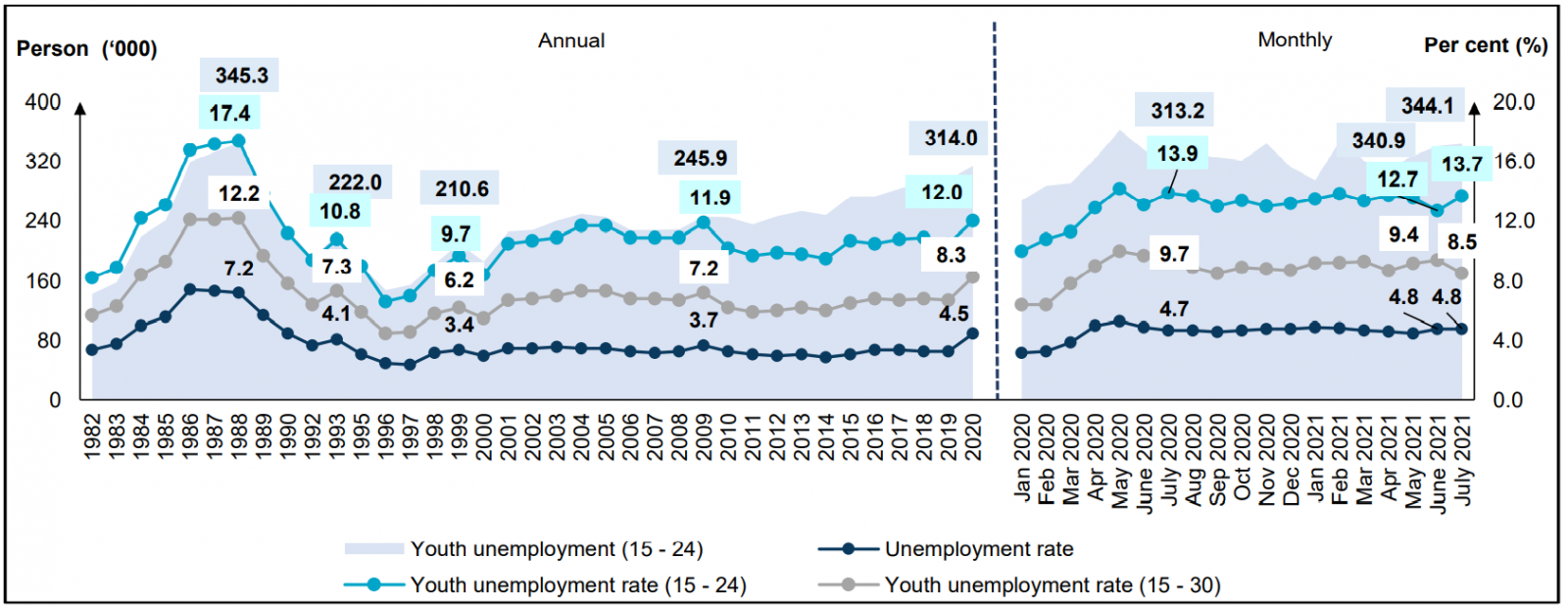
LFPR in July 2021 stood at 68.3 per cent
The number of labour force in July 2021 was slightly higher by 6.7 thousand persons to post 16.07 million persons after registering decreases in the preceding months. The labour force participation rate (LFPR) during the month stood at 68.3 per cent.
Comparing to July last year, the number of labour force added by 254.4 thousand persons (1.6%) as against 15.82 million persons. Likewise, the LFPR rose by 0.2 percentage points from 68.1 per cent in July 2020. [Chart 6]
Chart 6: Labour force and LFPR, 1982 – 2020 and January 2020 - July 2021
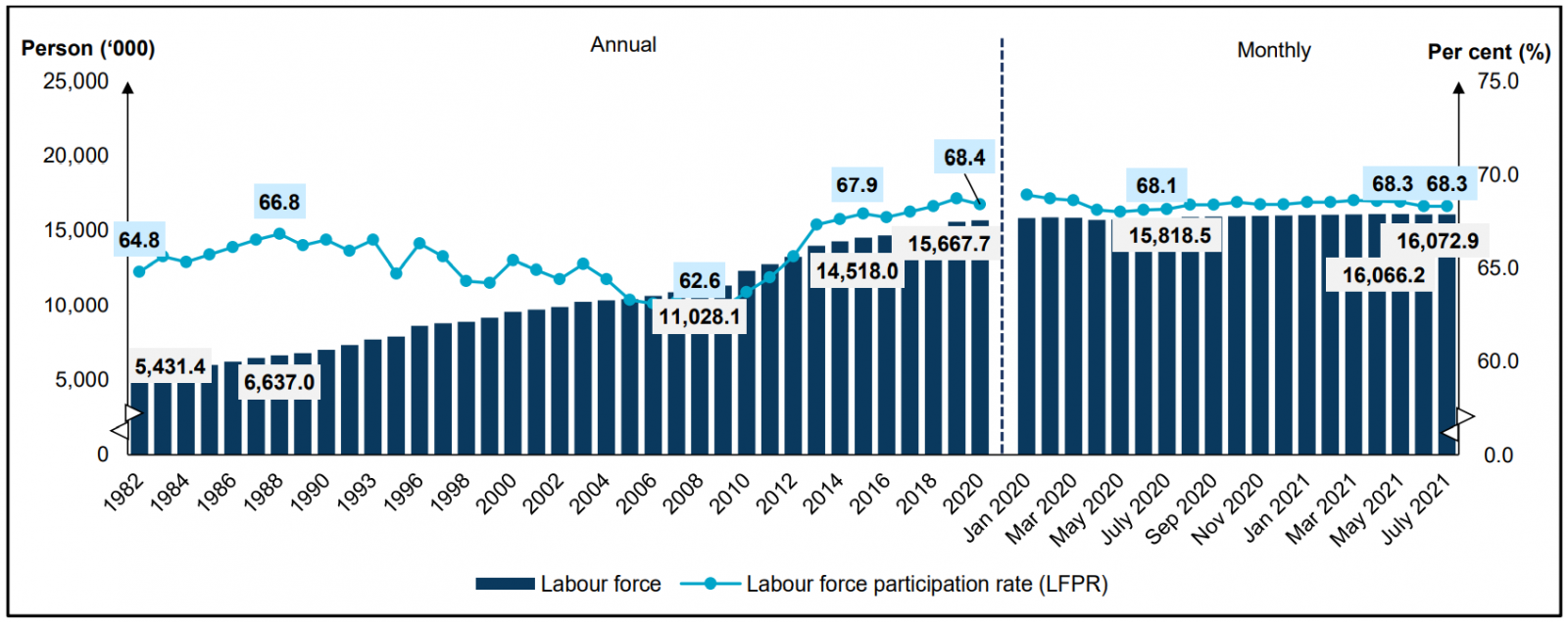
Both male and female LFPR posted a decline in July 2021 by 0.6 percentage points to 81.0 per cent and 54.6 per cent respectively. The number of male labour force escalated by 3.2 per cent in July to record 9.86 million persons (June 2021: 9.51 million persons) after recording reductions for three consecutive months. Meanwhile, the number of female labour force fell by 5.1 per cent to 6.21 million persons (June 2021: 6.55 million persons). Year-on-year comparison, male LFPR heightened by 0.6 percentage points from 80.4 per cent in July 2020 while female LFPR dropped by 0.5 percentage points (July 2020: 55.1%). [Chart 7]
Chart 7: Labour force and LFPR by sex, 1982 - 2020 and January 2020 - July 2021
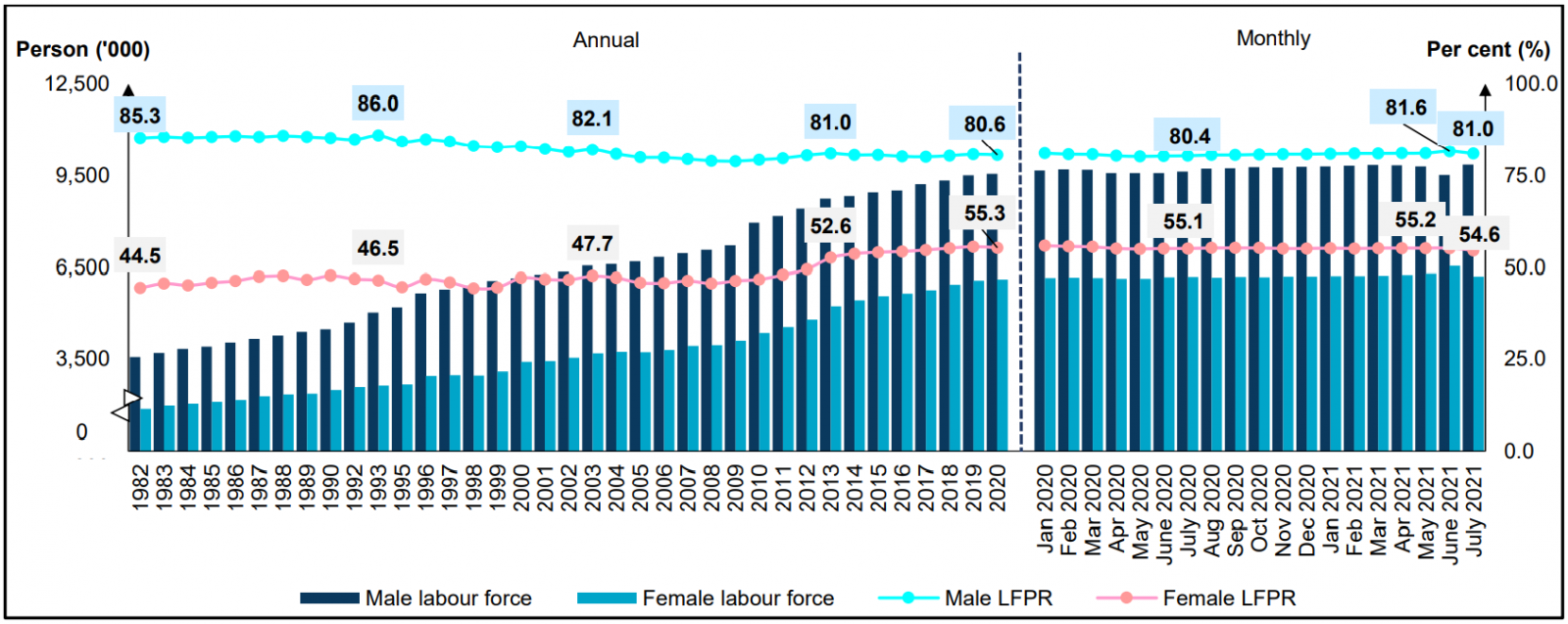
Housework/ family responsibilities was the major composition of outside labour force
In July 2021, the number of outside labour force continued to increase for the fourth month by 0.3 per cent or 18.7 thousand persons to register 7.48 million persons (June 2021: 7.46 million persons). Similar trend was witnessed on the year-on-year basis whereby the number of outside labour force augmented by 75.6 thousand persons (1.0%). Housework/ family responsibilities was the major composition of outside labour force with a contribution of 46.4 per cent and followed by schooling/ training category (39.2%). [Chart 8]
Chart 8: Share of outside labour force by reasons for not seeking work, June and July 2021
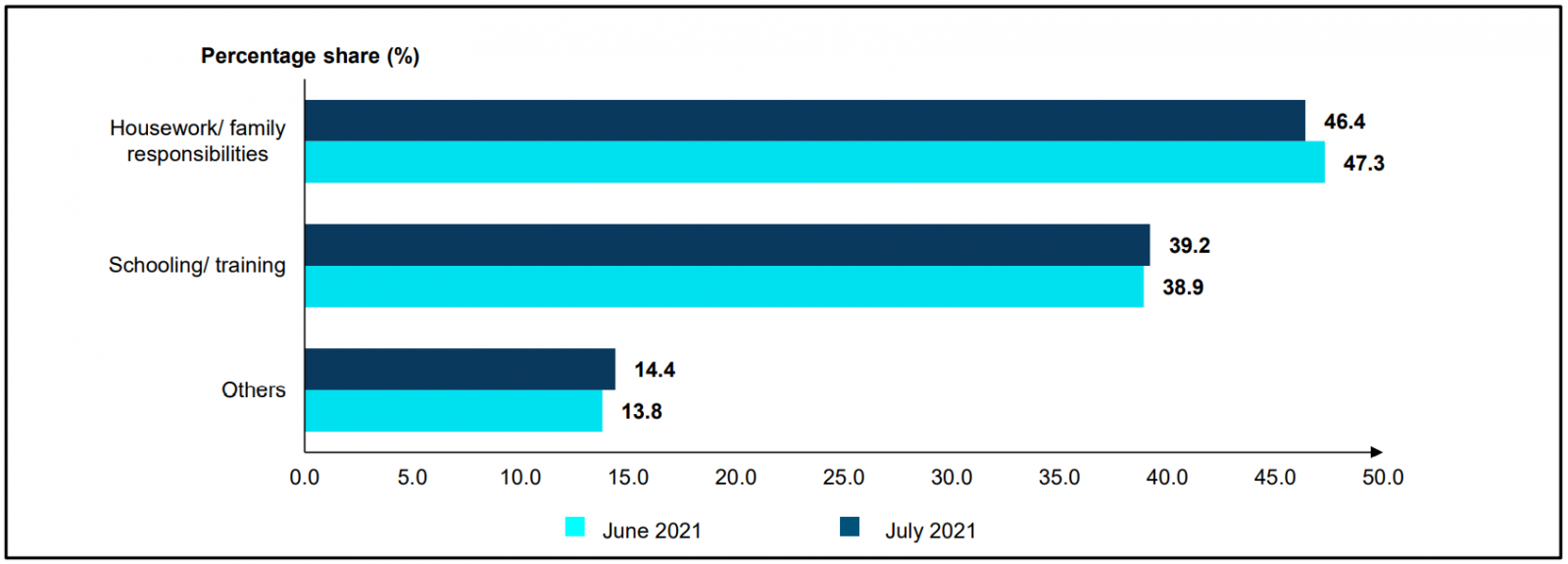
GOVERNMENT’S INITIATIVES2
To support every segment of the targeted groups, various government initiatives had been executed to ensure the livelihood and business continuity. As of 30 July 2021, a total of 322,177 employers and 2.64 million registered employees had benefitted from the Wage Subsidy Programme (PSU 1.0) under PRIHATIN and PENJANA with an approved value of RM12.91 billion. In the meantime, to further support the employers and employees, a total RM1.33 billion has been channelled to 77,226 employers and 681,838 employees through the Wage Subsidy Programme (PSU) 2.0. A total of 137,659 employees managed to be hired under the Hiring Incentive Programme and Training Assistance particularly in Manufacturing and Wholesale and retail trade industries. Furthermore, a total of 150,908 individuals had been accepted to participate in the Reskilling and Upskilling Programme.
To empower businesses, a total of RM12.28 billion of approved and accepted applications have benefited 25,927 Small, Medium Enterprise (SMEs) through the SME soft loan fund comprising of Special Relief Facility (SRF), Automation & Digitalisation Facility (ADF), All-Economic Sector Facility (AES) and Agrofood Facility (AF) funds. Moreover, under PENJANA Tourism Financing which was allocated for SMEs and micro-SMEs that are still affected by the COVID-19 pandemic, 336 out of total 680 applications were approved totalling RM66.6 million. Subsequently, Bumiputera Relief Financing (BRF) had assisted 749 SMEs with a financing value of RM226.8 million funds. In the meantime, 12,667 Micro SMEs including in the retail and services sectors benefited from the PENJANA Micro Credit Financing involving a total value of RM421.2 million. As for the TEKUN Business Recovery Scheme (TBRS) which was mainly allocated to assist the Micro SMEs, a total of 14,946 Micro SMEs had been facilitated reaching the objective of RM100 million distribution of fund. Next, under the Agrobank Microcredit Financing Scheme which aims to support the Agriculture and Food Industry, a total of RM171.64 million has been channelled to 13,871 Agricultural Micro SMEs including farmers, planters and fishermen.
To support the Technical and Digital Mid-tier Companies (MTCs) and Digital Adaption, a total of RM79.25 million had been channelled to support 13,877 businesses through the National Economic Regeneration Plan (PENJANA). Furthermore, to assist SMEs in adopting digitalisation services in day-to-day business operations to increase business competitiveness and productivity, Bank Simpanan Nasional had provided matching grants to SMEs. As of 30 July 2021, 30,938 SMEs were aided involving a total value of RM82.32 million. To support the Arts, Culture and Entertainment Sector, through the CENDANA initiative, a total of RM4.37 million had benefited 535 recipients including artists, collectives and organisations who were actively involved in the Malaysian arts and culture industry.
LOOKING AHEAD
In August and early September 2021, the implementation of NRP is on-going to ensure efforts to rejuvenate the economy while containing the high daily number of new COVID-19 cases and deaths. This has influenced the recovery process of Malaysia’s economy as well as labour market. The continuous effort in battling the pandemic in the country was seen as Malaysia became one of the fastest countries in vaccinating the people, recording more than 500,000 doses a day through the National COVID-19 Immunisation Programme (NIP). As of 6 September 2021, the cumulative number of vaccinations has exceeded 36.7 million doses covering 68.8 per cent of adult population who have completed the vaccination. The execution of the NRP had allowed certain states to move into new phases namely Perlis and Sarawak into Phase 3 and W.P. Labuan into Phase 4. During Phase 3 of the NRP, more relaxation of economic activities was exercised including permission for domestic tourism activities within the same state involving hotels and homestays restricted for those who had completed vaccination. In addition, all industries within the distributive trade sector were allow to resume their operation. In the meantime, in Phase 4 of the NRP, all economic activities may run as usual in accordance to the SOPs.
On 16 August 2021, eleven business activities were allowed to continue operating under Phase 1 of the NRP namely car wash services; electrical and electronics; household items and kitchenware stores; sport equipment stores; car accessories store; car distribution sales centres; clothing; fashion and accessories stores; jewellery stores; barbershop & beauty centres/ salons; morning markets & farmers market; as well as furniture stores. Adding to this, effective on 20 August 2021, additional leeway was given for those who completed their vaccinations including permission to dine in. Moreover, night markets and weekly markets are allowed to operate in Phase 1 of NRP but are restricted to fully-vaccinated customers. Individuals and paired sport, recreation and leisure activities without physical contact are also permitted during this phase, but limited to frequenting recreational centres within the same districts.
Generally, the labour market is positively associated with the economic performance. Hence, the implementation of NRP has allowed some flexibility for economic and services activities to resume in line with the NRP’s phases. This targeted strategy has brought some light for the labour market to recover progressively. With the permission for more business activities to reopen under Phase 1 along with transitions of some states into Phase 3 and Phase 4, more labour market activities are foreseen in the upcoming months. Nonetheless, due to uncertain public health situation, the challenges to the labour market may persist. On this note, collaboration and awareness of the whole nation comprising of individuals, community as well as businesses are crucial to ensure herd immunity can be achieved, thus will be able to revive the country's economy and labour market.
TECHNICAL NOTES
This information is derived from the Labour Force Survey (LFS) which was conducted to collect information on the structure and distribution of labour force, employment and unemployment.
The survey population cover persons who live in private living quarters and excludes persons residing in institutions such as hotels, hostels, hospitals, prisons, boarding houses and workers residing in construction work site.
The survey comprises of the economically active and inactive population. To measure the economically active population, the LFS uses the age limit of 15 to 64 years. The economically active population comprises of those employed and unemployed whereas those who are inactive is classified as outside the labour force.
LFS uses the actual status approach, where a person is classified on the basis of his labour force activity during the reference week.
- Labour force refers to those who, during the reference week are in the 15 to 64 years (in completed years at last birthday) and who are either employed or unemployed.
- Employed refers to all persons who, at any time during the reference week worked at least one hour for pay, profit or family gain (as an employer, employee, own-account worker or unpaid family worker). Also considered as employed are persons who did not work during the reference week because of illness, injury, bad weather, leave, labour dispute and social or religious reasons but had a job, farm, enterprise or other family enterprise to return to. Also included are those on temporary lay-off with pay who would definitely be called back to work.
- Unemployed
Unemployed refers to those who do not have a job but are interested to work. There are two groups of unemployed that is the actively unemployed and inactively unemployed.
- Outside Labour Force
All persons not classified as employed or unemployed as stated above are classified as outside labour force. Includes housewives, students (including those going for further studies), retired, disabled persons and those not interested in looking for a job.
- Labour Force Participation Rate
The economic activity of a population depends on the demographic characteristics of that population. The proportion of economically active population, therefore, differs between sub-groups of that population. These variations are measured by specific activity rates termed as labour force participation rate. Labour force participation rate is defined as the ratio of the labour force to the working age population (15 to 64 years), expressed as percentage.
- Unemployment rate is the proportion of unemployed population to the total population in labour force. This rate measures the percentage of unemployed population in the labour force.
Population by characteristics of age group, ethnicity and state were used as benchmarks to produce labour statistics.
Starting with the monthly release of the Principal Statistics of Labour Force, Malaysia, January 2016, the principal statistics of labour is estimated based on the current population estimates as compared to the previous series which used population projections based on the Population and Housing Census of Malaysia, 2010. This rebase is to obtain statistics that is more consistent with current population structure.
The full publication of the Labour Force Report, July 2021. This report is accessible and downloadable through the application eStatistik Portal, Free Download
For more details, please refer to the Department’s portal: www.dosm.gov.my
Released By:
DATO' SRI DR. MOHD UZIR MAHIDIN
CHIEF STATISTICIAN MALAYSIA
DEPARTMENT OF STATISTICS, MALAYSIA


9 September 2021
Contact person:
Mohd Yusrizal bin Ab. Razak
Public Relation Officer
Strategic Communication and International Division
Department of Statistics, Malaysia
Tel : +603-8885 7942
Fax : +603-8888 9248
Email : yusrizal.razak@dosm.gov.my
Subscribe
Newsletter
Subscribe to our newsletter and stay updated
For interviews, press statement and clarification to the media, contact:
Baharudin Mohamad
Public Relation Officer
Email: baharudin[at]dosm.gov.my
Phone: 03 8885 7942
Not found what you looking for? Request data from us, through
Go to eStatistik
email to data[at]dosm.gov.my
call 03 8885 7128 (data request)









